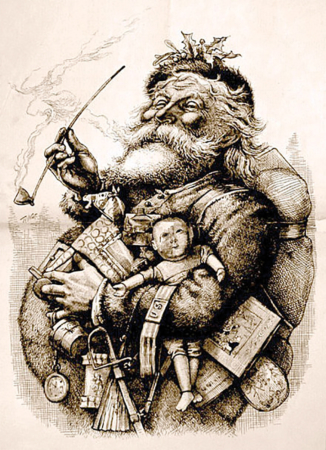He dresses quite strangely though the description changes and eyewitness accounts vary. In some locations, he wears big green robes. Other witnesses have him dressed as a dirty figure carrying a stick. Often, however, he has been spotted wearing a flamboyant outfit of red velvet with a matching hat and big black boots. He probably has type 2 diabetes and may battle high blood pressure, as most accounts describe him as obese, and it is rumored he largely subsists on a diet of cookies and milk. He is a world-class cat burglar in spite of his size. Evidence points to him, breaking into literally millions of homes across the world annually. Some accounts say he is a drinker and a brawler. Still, after all of that, he is one of the most beloved figures in human history.
If you guessed that Santa Claus is our wanted felon, you are partially correct. He is known by many names. In Belgium and France, he is known as Pere Noel, in Chile, his name is Viejo Pascuero, in the Netherlands, it is Kerstman or Sinterklaas, in Brazil he is known as Papai Noel, in Finland, it is Joulupukki, in Germany, his name is Weihnachtsmann or Christkindl, in Italy it is Babbo Natale, in Norway, he is known as Julenissen, in the UK he is Father Christmas, in Sweden, he is Joltomten, in Russia he is Ded Moroz, Poland calls him Swiety Mikolaj (St. Nicholas), in Hungary, he is Mikulas (also St. Nicholas), Dun Che Lao Ren (Christmas Old Man) is his name in China, Kanakaloka in Hawaii, and Hoteiosho in Japan. He also has many informal names such as St. Nick, that Jolly Old Elf, Santa, Father Christmas, and Kris Kringle. The list goes on and on with both many formal and informal names. Religious conflict within Christianity, coupled with pagan influences, has mixed and muddied the many versions of this beloved character over the centuries, and the origin of some names is debatable.
Darker versions have also sprung up throughout history, including Krampus, Knecht Ruprecht, and Pelznickel. Krampus was known to be a demon-like monster with horns that stole away the worst of children and ate them in his cave, and Pelznickel, also known as Belznickel, is said to dress in dirty clothes or matted firs and carry a switch to beat misbehaving children. These darker versions are a bit scarce in North America, however, occasionally making appearances at festivals that are usually of a Germanic theme. In Europe, however, they are more commonplace during the Christmas season.
Though there have been many “Santas” over the years, St. Nick was actually based on a real-life Saint Nicholas who is believed to have lived from 270-343 AD. He was born to wealthy parents in the village of Patara, which is now part of Turkey and was known to be generous and protective of children. A recurring story tells of a father that had three daughters but was too poor to offer a dowery so that they could be married. This was very significant in those days and meant that the girls would likely fall into a life of prostitution as their only means of survival. Hearing of this, he provided the three girls with dowries by throwing gold through an open window. It is said that the gold landed in shoes or stockings that had been placed by a fire to dry, thus beginning the tradition of placing stockings on the mantle by a fireplace. His generosity was boundless, and he is reported to have used his entire fortune to help the sick and the needy.
Nicholas was known as such a devout Christian that he was made Bishop of Myra, an area that has changed hands many times but is now in present-day Turkey. He is said to have died on December 6th, 343, and because of his love of children, the tradition of giving gifts in honor of the death of St. Nicholas became custom. December 6th remains as a day of gift-giving in many European countries to this day.
Like his name, the look of Santa Claus has changed many times. Still, the modern image of a portly older gentleman with a beard and spectacles was popularized in North America by the 1823 poem, “A Visit from St. Nicholas,” better known as “‘Twas the Night Before Christmas,” which was published anonymously in 1823. The poem was later attributed to Clement Clarke Moore, who claimed authorship in 1837. It was later contested that the true author was Henry Livingston Jr., who penned the poem, which was supported by content analysis, though credit for the piece is still generally given to Moore.
The image was further strengthened by cartoonist, Thomas Nast, with an 1881 illustration in Harper’s Weekly. This drawing became so popular that it is still reproduced today and has cemented our image of modern-day Santa Claus that is used in celebration and advertising around the world.
‘Twas the night before Christmas, when all through the house, not a creature was stirring, not even a mouse.
The stockings were hung by the chimney with care,
in hopes that St. Nicholas soon would be there…
Regardless of where you are from, what you call him, or what you believe he looks like, Santa Claus has had a profound impact upon the season of Christmas throughout history. He is a character that brings joy to children and signals the anticipation of Christmas morning. For adults, he reminds us of a simpler, more innocent time. He is part of the magic that remains in this fast-paced, digital world and allows us to forget our troubles for a brief moment.
Oh, by the way, he IS real!





Leave a Comment
Your email address will not be published. Required fields are marked with *